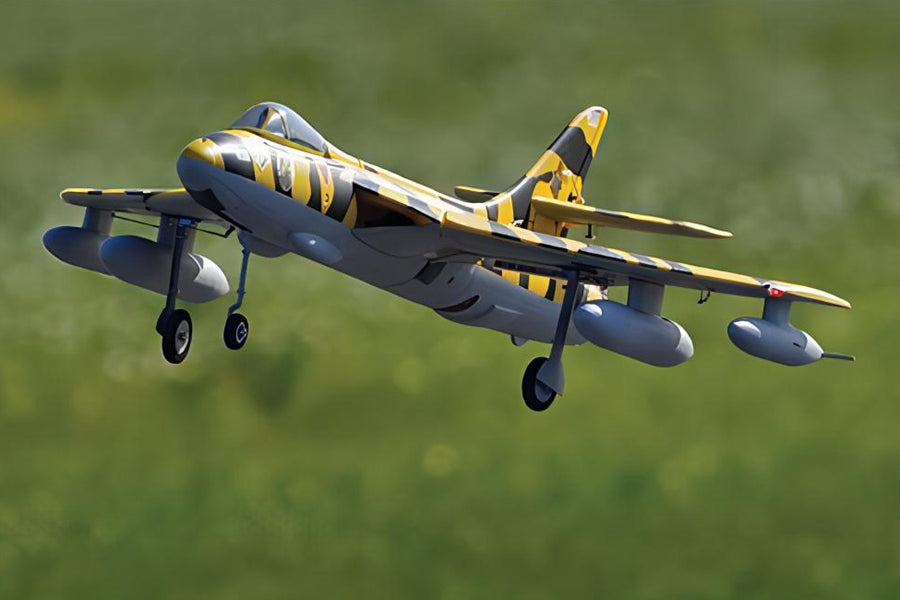Introduction
Remote Control (RC) jet planes have captivated hobbyists and aeronautics enthusiasts alike. With their sleek designs and high-speed capabilities, these miniature aircraft offer a thrilling experience for both novice and experienced pilots. This blog will explore the history, technical specifications, and features of RC jet planes, with a special focus on Dynam RC jet planes, which are particularly well-suited for beginners.
History of RC Jet Planes
The journey of RC planes began in the early 20th century, but the development of RC jet planes took off in the latter half of the century. The first successful radio-controlled aircraft was built in the 1930s, but it wasn't until the 1950s that jets entered the picture. Early models were often constructed from wood and featured simple propulsion systems.
The Evolution of Jet Technology
The late 1960s saw significant advancements in jet technology, primarily due to the introduction of turbine engines. These engines allowed for higher speeds and more realistic flight experiences. The first commercial jet engine designed for RC models emerged in the 1970s, marking a pivotal moment in the hobby. This period also saw the rise of electric-powered models, which gained popularity for their ease of use and maintenance.
By the 1990s, the development of lightweight materials like foam and carbon fiber revolutionized the design of RC jet planes. These materials allowed for more agile and durable aircraft, appealing to a broader audience. Today, modern RC jet planes are equipped with sophisticated electronics, including advanced flight control systems, making them more accessible to beginners.
Technical Specifications
1. Size and Scale
RC jet planes come in various sizes, typically ranging from small, micro-sized models to larger scale replicas. Beginners may find it beneficial to start with smaller models, which are easier to handle and less intimidating.
2. Power Source
RC jets can be powered by three main types of propulsion systems:
Electric Motors: These are the most common power source for beginners. Electric jet planes are quieter, easier to maintain, and often more affordable. They also eliminate the need for fuel, making them a cleaner option.
Nitro Engines: Nitro-powered jets are generally more powerful and can provide a more realistic flying experience. However, they require more maintenance and are less suited for beginners.
Turbine Engines: These are the pinnacle of RC jet technology, offering incredible speed and realism. Turbine jets are typically reserved for experienced pilots due to their complexity and cost.
3. Flight Control Systems
Modern RC jets are often equipped with advanced flight control systems that enhance stability and maneuverability. These systems may include:
Gyroscopic Stabilization: This technology helps maintain level flight and improves handling, making it easier for beginners to pilot their planes.
Telemetry Systems: Advanced telemetry systems provide real-time data about battery life, altitude, and speed, allowing pilots to monitor their planes during flight.
4. Materials and Construction
RC jets are constructed from various materials, including:
Foam: Lightweight and durable, foam models are ideal for beginners. They are typically more forgiving in crashes.
Balsa Wood: While heavier, balsa wood provides excellent structural integrity and is often used in more advanced models.
Composite Materials: Some high-end models utilize composite materials for improved strength and performance.
5. Range and Flight Time
The range of RC jets can vary significantly based on the power source and model. Electric jets generally have a flight time of around 5 to 15 minutes, while nitro and turbine jets may offer longer flights depending on fuel capacity.
Features of RC Jet Planes
1. Ease of Use
One of the primary considerations for beginners is ease of use. Many modern RC jet planes come ready-to-fly (RTF), meaning they include everything needed to get started, including a transmitter and battery. This convenience allows beginners to focus on learning to fly rather than assembling their aircraft.
2. Aerodynamic Design
RC jet planes are designed with aerodynamics in mind, ensuring they fly smoothly and efficiently. Features such as swept wings and thrust vectoring contribute to improved performance and maneuverability.
3. Durability
For beginners, durability is a critical factor. Many entry-level models are designed to withstand crashes and rough landings, making them forgiving choices for those still mastering their flying skills.
4. Customization Options
Many RC jet planes allow for customization, enabling pilots to personalize their aircraft with different paint schemes, decals, and upgrades. This feature adds a layer of creativity and engagement to the hobby.
Dynam RC Jet Planes for Beginners
Overview of Dynam
Dynam is a reputable brand known for producing high-quality RC aircraft, including rc jet planes for beginners that cater specifically to beginners. Their models are designed to be user-friendly, durable, and affordable, making them an excellent choice for those new to the hobby.
Popular Models
Dynam Cessna 550
The Dynam Cessna 550 is an ideal entry-level model that combines a classic design with stable flight characteristics. Powered by an electric motor, it comes with a pre-installed ESC (Electronic Speed Controller), making it easy for beginners to operate. Its lightweight foam construction ensures durability, and its low stall speed makes it forgiving during landings.
Dynam Gloster Meteor
The Dynam Gloster Meteor is another excellent option for beginners. This model features a high thrust-to-weight ratio, providing exhilarating speed and agility. Its user-friendly design and built-in stabilization systems help novice pilots maintain control during flight.
Dynam Hawker Hunter
The Hawker Hunter is a versatile model known for its sleek design and performance capabilities. Its robust construction can withstand rough handling, making it a fantastic choice for those just starting. With a simple assembly process and good flight characteristics, it allows beginners to experiment with different flying styles.
Features of Dynam RC Jets
RTF Options: Most Dynam jets come as ready-to-fly kits, allowing beginners to start flying with minimal setup.
Durable Materials: Dynam jets are built using tough foam, ensuring they can endure the inevitable bumps and crashes that occur during practice.
Performance: With their powerful motors and aerodynamic designs, Dynam RC jets offer excellent performance and maneuverability, allowing new pilots to quickly develop their skills.
Support and Community: Dynam has an active online community and support resources, making it easier for beginners to find help and advice as they learn.
Conclusion
RC jet planes offer a thrilling way to engage with aerodynamics and flight dynamics. Their rich history, combined with modern technological advancements, has made them accessible to hobbyists of all skill levels. For beginners, Dynam RC jet planes provide an excellent entry point into this exciting world, thanks to their user-friendly designs and durable constructions. Whether you're looking to simply enjoy the thrill of flying or aspire to master advanced piloting skills, the right RC jet can set you on a path to endless fun and exploration in the skies.









